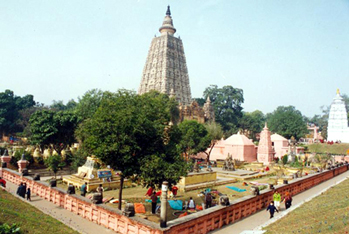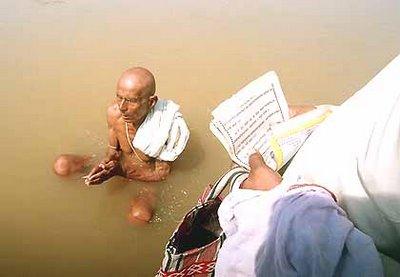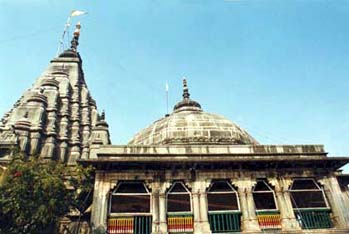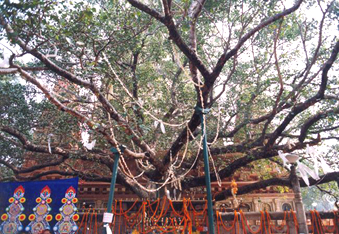|
Hullo, people,
That Bihar is the cradle of at least four internationally accepted religions is old hat -- everyone knows about it. As it happens, the most revered, the purest, the most divine stretch of land for all Hindus also happens to be here.
This stretch of land has all the benefits and divinity of all the pilgrimages, all the seven holy rivers, the various dhaams and jyotirlingas, et al.
This is Gaya.
 Oh, no, not the Gaya with Buddhist claims to fame. Not the Gaya where every Buddhist nation in the world has land and a temple of its own. Not the Gaya, either, where grows the renowned Bodhi tree (said to be the seventh generation of the same tree growing at the same place).
This is a different Gaya.
 If you remember, I mentioned pitripaksha the other day -- the dark fortnight which we Hindus devote to a sort of thanks-giving to our forebears. Well, for pitripksha all of Hindu India comes to the dry gleaming sands of the river Phalgu to perform the pinda-daan -- the offering of a womb. If you remember, I mentioned pitripaksha the other day -- the dark fortnight which we Hindus devote to a sort of thanks-giving to our forebears. Well, for pitripksha all of Hindu India comes to the dry gleaming sands of the river Phalgu to perform the pinda-daan -- the offering of a womb.
The reason is simple -- this is the only place that, apart from being the purest, also happens to be where Brahma and Vishnu were actually joined by the god of death, Yamaraj, also known as Dharmaraj.
As it happened, in the jungles of this place lived a sage with his wife who was the daughter of Yamraj Yamputri.
One morning, as she was busy preparing the havan-samagri for her husband, she looked up to see the foul-tempered Durwasa Muni approaching.
She was in a quandary -- she knew that if she did not at once stop what she was doing and extend a formal welcome to the sage he would be furious -- and may curse her husband for all she knew. But she also realised that she must complete the chore she had on hand first.
Thinking to herself, 'If my husband does get angry with me, I'll explain to him and he'll understand ...' she stepped forward to welcome Durwasa Muni.
But she had no idea what husbands and their tempers can be like -- her husband cursed her and she was turned into a stone -- to lie there forever until Lord Vishnu's feet touched her and brought her back to herself.
Then came along a demon -- Gaya (yes, we in India do name cities after demons just as the British talk more about their defeat at Dunkirk than their victories like El Alamein.)
Gayasur was a great devotee of Lord Shiv and he started penances to appease his lord. Now, everyone knows that Shiv is also known as Asutosh because it doesn't need much to satisfy him. That wouldn't have mattered much had it not jeopardised the well-being of everything else under the sky.
All of the three worlds held their breaths in unison as Shiv decided to bless his devotee Gayasur. He appeared and reeled out his usual dialogue, 'Maang, baccha, kya maangta hai ...?'
And Gayasur said, 'Lord, I don't ask for much, just that this body of mine be given all the holy attributes of all the pilgrimages, the dhaams, the seven rivers and the holy mountains ...'
Tathastu -- and the deed was done.
Just as promptly, Gayasur embarked on his career of destruction and launched his reign of terror against the sadhus, sages, citizens ...
Poor Indra Dev's throne went into shivers and the other gods gathered to discuss the matter. They went to Brahma. Brahma knew his limitations and told them there was little he could do against any blessing given by Asutosh himself. Why not approach Lord Vishnu?
Lord Vishnu gave it all his serious consideration and came up wth a brilliant idea -- why not approach Gayasur with folded hands and humbly ask him for the loan of his body which had the attributes of all the holiness needed for any yajna.
Delighted, the gods approached Gayasur and fool that he was he was delighted at the thought of having all the gods asking for such a favour and putting themselves in debt to him forever.
He obligingly spread himself out.
The gods quickly placed the stone that was Yamaputri and started on preparations for their yajna. All the gods stood on the stone and invoked the creative energies around them. Brahma came along to watch the fun and Yamaraj came to lend moral support to his daughter. And the yajna went on and on ...
Gaya got tired a bit. Then he became suspicious. Still he waited. And the gods assured him they were almost done. And some more time passed by.
Now Gayasur started getting slightly fed up. He started heaving his body up.
 The gods prayed harder. Still, Gayasur shifted his limbs. That really scared the gods and they finally raised their arms and prayed to Vishnu for help. The gods prayed harder. Still, Gayasur shifted his limbs. That really scared the gods and they finally raised their arms and prayed to Vishnu for help.
Lord Vishnu came and stood on the stone till Gayasur's life was crushed out of his body.
The temple is called Vishnupad -- and there on a stone are the huge footprints, believed to be Lord Vishnu's.
Now you know why that is the purest land for us Hindus -- and because Yamaputri had such a role to play that it even got her father to come, that is the best place in the world to offer pinda to one's forebears.
Yamaputri received many blessings. Here one can perform one's own pinda-daan during one's lifetime. And here, the offering of only one pinda-daan is enough -- you don't have to go every year.
A special class of Brahmins whose name I forget are the pandas here who help you with the last rites. But the sad thing is these Brahmins are at the edge of extinction -- there are just not enough boys and girls to marry each other and carry on.
But around the Vishnupad temple there are at least 65 places of worship -- like Sita came here to offer pinda to her father-in-law, King Dashrath -- a daughter-in-law's offerings are acceptable, not a daughter's.
 And from the foot of the Bodhi tree one could see a tiny hill reminiscent of a child's drawing where Rama and Lakshman had stopped and been offered a meal by a tribal woman named Shabari -- yes, she was the one who tasted each ber to see whether it was sweet or not.
That apart there is the Bodhi tree -- and a Buddhits temple built by every Buddhist nation in the world.
This is Gaya.
A decade or so ago, it was the heart of Naxal Bihar, the centre of what the media named, 'the killing fields'.
And it is my observation that if there is a murder or a massacre it is executed around noon or an hour or so later. The reason is simple -- you get together the evening before, have a tot or two and a bite or two while planning out the last intricate details and then rest to garner strength.
By the time you get up, you have a the-morning-after head and a little fear veiled under some uncertainty creeps into you. By the time you prime yourself to go kill, it is noon.
We usually got the news an hour or so later. And that would start off a wild scramble for cabs.
There weren't many in Patna then but the Press in Patna did work rather excellently (why else do you think you know about every sneeze of Laloo's and nothing about Mulayam?)
In any case, everyone garbbed a cab or two and hurried over to the 'spot' or Mauka-e-Vaardat. And it goes without saying that the cab that fell to my lot wasn't started in probably a year or two and had a driver who knew only how to open doors.
Exactly this happened when the BJP candidate, a highly respected, highly popular man, Ishwar Choudhary, was gunned down in broad daylight. And he was a backward leader which gives you even less reason for the heinous act. Backwards oughtn't to be killing backwards.
Be that as it may, my kid of a photographer and I hurried over.
But getting to Gaya totally depended on the moods of the mauraders of Masaurhi and Jehanabad. In fact, God's reign started at the point where the New Patna Bypass pauses uncertainly whether to turn left and run on to north Bihar via the world's then longest river bridge, Gandhi Setu, or to turn and make a straight line into the killing fields.
We got there. The sands of the Phalgu were not to be seen. The DM estimated that there was a crowd of about 800,000 present. And there was not a woman to be seen. No windows slid open an inch to falicitate a peep or two, no doors were open. The only sari to be seen was mine --
-- and people say I've not seen evil.
This is where the photographer and I parted company. He headed for the fureral pyre in the middle of the crowd where a poor son held a stick of fire in one hand to say bye-bye to his father. And I made a round of the crowd, talking to this one and that ...
And I bumped into a man with loads of reddish grazes, lint and band-aids from his temple to feet.
'What happened to you?'
'Hum hi na unke saath they ...'
I grabbed his arm and looked for cover -- no one must see me talking to him -- Raju Sah -- and I made for an abandoned set of ghat steps that must have once led bathers down to the river below.
'I was in the front seat. His car came up the slope and had just straightened up on the highway when this jeep came along and jammed us into a stop. The jeep had the Janata Dal wheel and this man's cut-out and everything. Then they came quickly, opened the gates, dragged us out...'
Raju Sah was in the front seat and when they threw him out of the car he happened to land
at the left side of the road where he slithered down the slope a little.
From there he saw it all. The others were on the other side of the car.
Ishwar Choudhary was to the left in the back seat. One man with a gun came and dragged him out. Then he hit him viciously in his stomach with the butt of his gun. The old man vomitted and wet himself.
'... I heard him say 'Die, die, in your own vomit, in your own peshab ...'
He was shot repeatedly in the chest.
I quickly climbed the sandy slopes to where the DM and SP were standing hoping no one had seen us talking -- and there came over the SP's man-pack, the news that the police had had to resort to firing at the Kotwali ....
Having covered that as well, we started back on the longest drive I've ever undertaken, back to Patna.
The car broke down.
Today, the only definite feeling I recall is the utter silence of the land -- and no land is ever completely silent.
A moon was climbing up the sky to our right, along the roads the saplings of the social forestry had been cut from within an inch of their roots. Nothing moved, nothing screeched, nothing lived.
A woman alone in a vacuum of silent fear that could not be formed into thought -- my sons were safe at home.
Worse was the plight of the two men -- having a woman with them --
The purest land on earth could do nothing for her ...
It was almost 1:30 when we took the last corner at the General Post Office of Patna and slid up to our office gate -- all five of my bosses were walking up and down, not within the campus, not on our road but on the road outside.
The photographer's job was over the moment he clicked his photograph -- and he needs only ten positives (never mind their quality) from every roll of film for audit purposes. Just ten. He can anyhow get the film to the office and to his lab assistant. That's it.
The reporter's job carries on through panic and hunger, thirst and the black shadows skimming across the sky. One letter at the wrong place can spell disaster or put you on some hit list or the other even if you hadn't been the only human being who had just spoken to the only eye-witness to a political killing involving the 'Uncrowned King of Bihar ' ...
The story blazed across six columns of the front page the next day -- From Shruti Shukla. But my parents were peacefully asleep and so were my sons when I had slipped quietly in the constantly open front door and peeped in and touched them through the cobwebby mosquito nets.
This is Gaya.
Comments...

|
Difficult to believe this is written by a journo. Very fresh and moving. The narration lets the reader deduce the emotional set up rather than fill it with cliches and inappropriate metaphors. Well done!
Partha Jha
parthajha@mac.com
|
|